#Reuben Flagg
Explore tagged Tumblr posts
Text


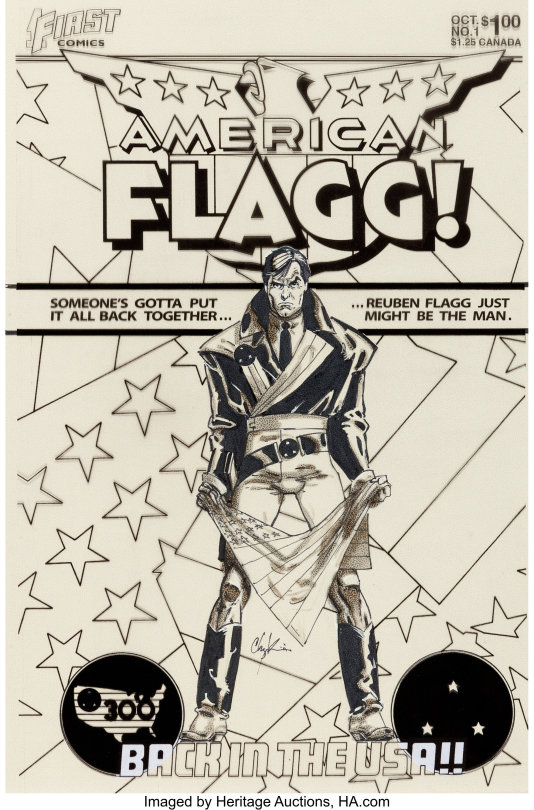

1983's American Flagg! #1 cover by artist Howard Chaykin. Source
#American Flagg!#Howard Chaykin#comics#Reuben Flagg#indie comics#first comics#cool comic art#cool cover art#cover#art#comic books#scifi#satire#future#1980s comics#80s comics#american flagg#USA#Howard Chaykin's American Flagg!#american flag#1980s#independant comics#cover art#original art#first issue#back in the usa#comic covers#comic book cover art#us comics#science fiction
60 notes
·
View notes
Text
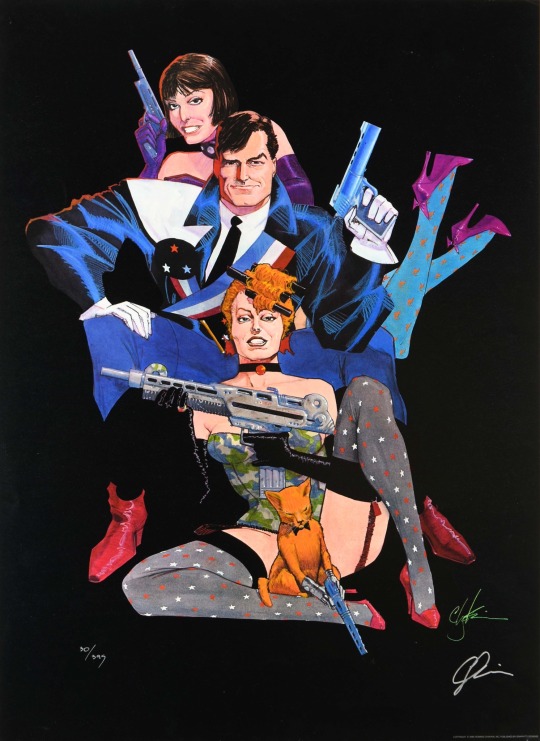
Howard Chaykin American Flagg Reuben Flagg & Friends lithograph (undated) Source
7 notes
·
View notes
Photo
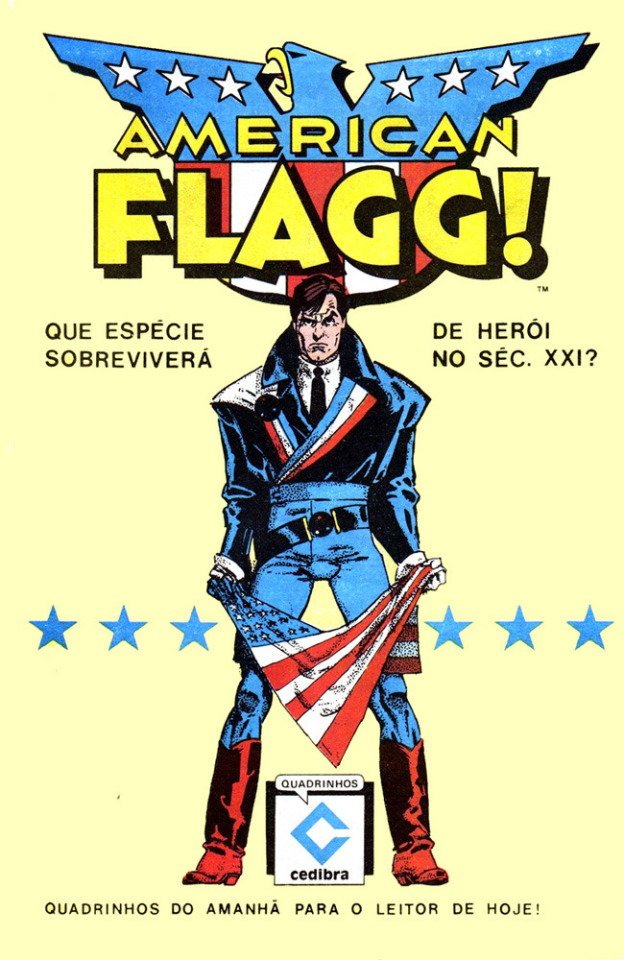
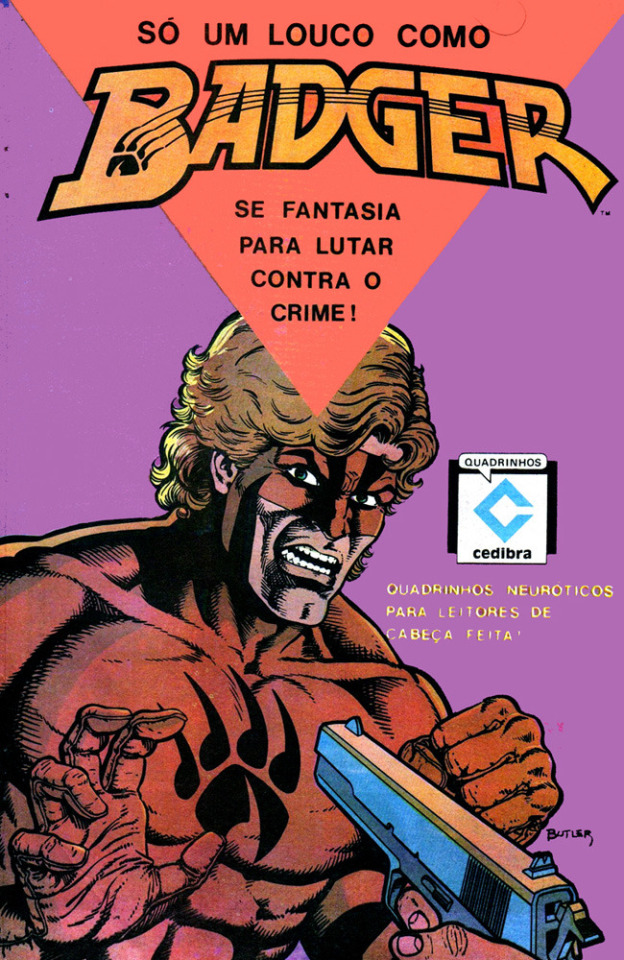
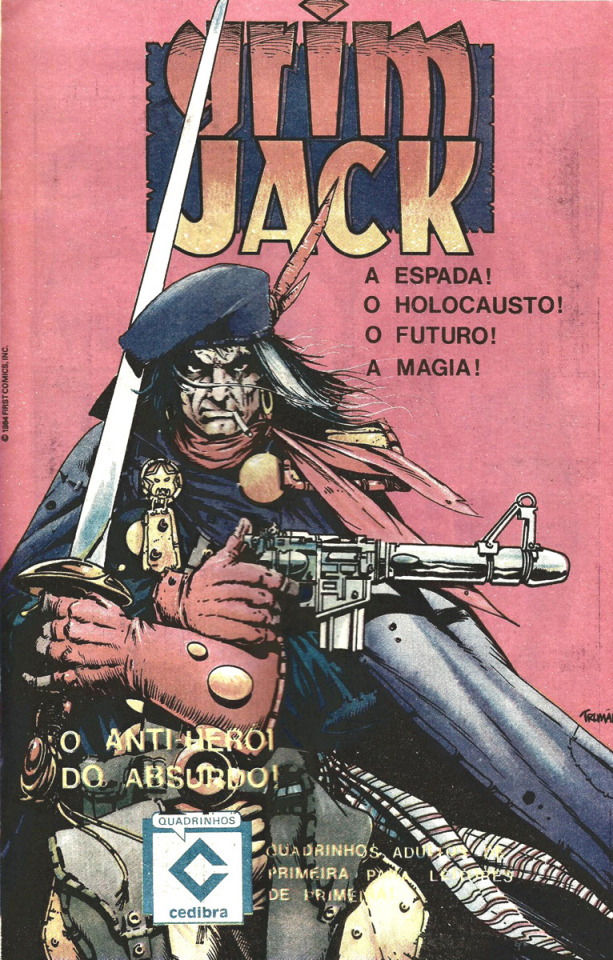
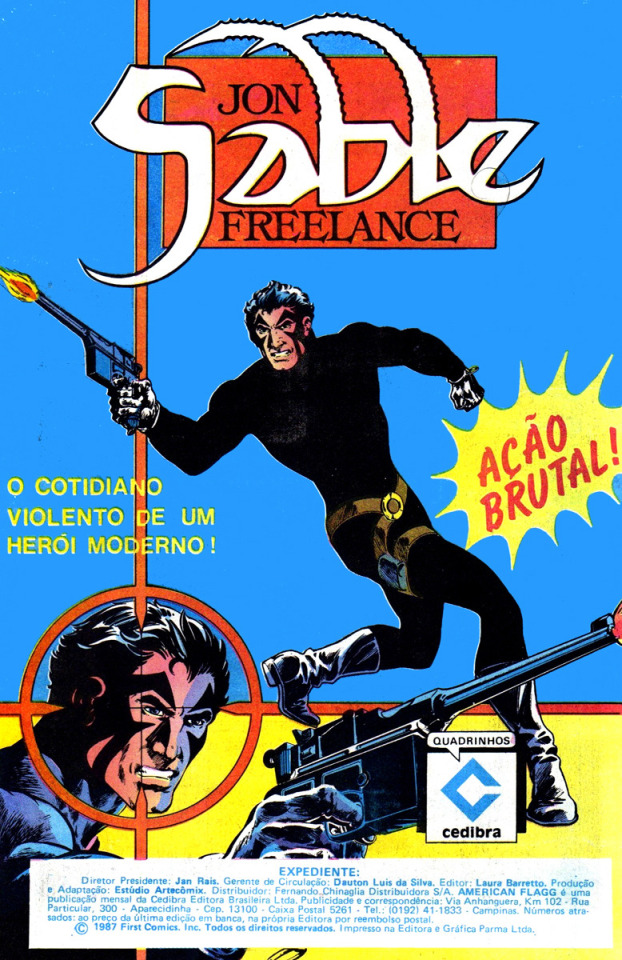
A different kind of heroes.
#cedibra#first#first comics#comics#80s#american flagg#badger#grim jack#jon sable#reuben flagg#howard chaykin#mike baron#bill reinhold#grimjack#john ostrander#timothy truman#capital comics#mike grell
13 notes
·
View notes
Photo
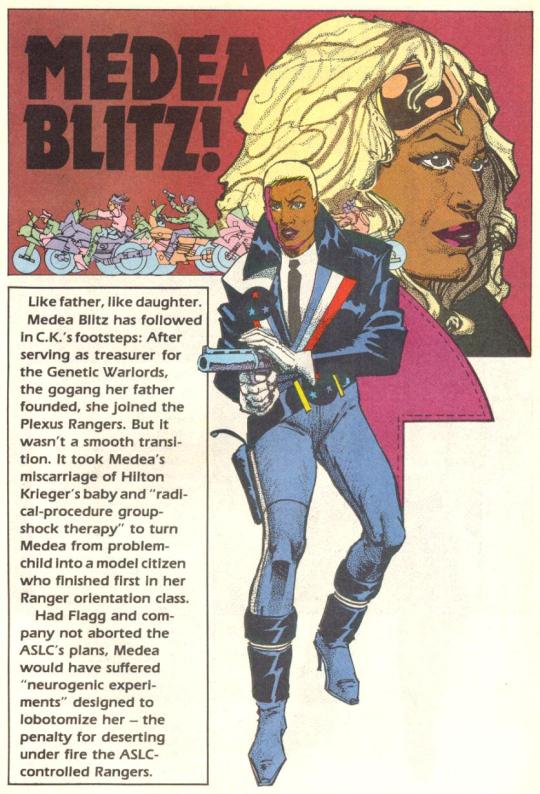
Medea Blitz profile page from American Flagg #15. 1984. Art by Howard Chaykin.
27 notes
·
View notes
Text
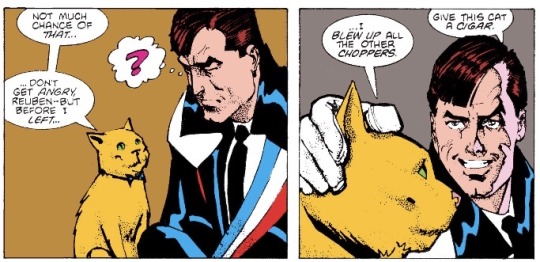
American Flagg! (1983) #10
17 notes
·
View notes
Video
youtube
American Flagg! is an American comic book series created by writer-artist Howard Chaykin, published by First Comics from 1983 to 1989. A science fiction series and political satire, it was set in the U.S., particularly Chicago, Illinois, in the early 2030s. Writers besides Chaykin included Steven Grant, J.M. DeMatteis, Alan Moore and John Francis Moore.
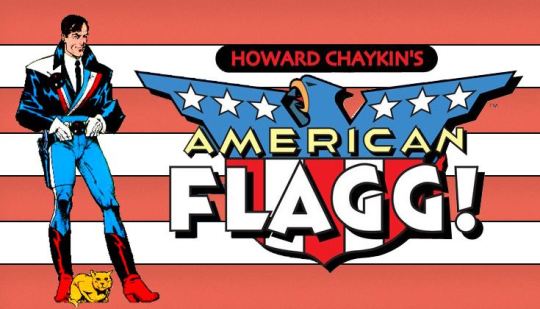
American Flagg, which ran 50 issues (October 1983 – March 1988), was one of the first titles to be published by First Comics, an early alternative press comics company founded in Evanston, Illinoisin 1983. Unusually for the time, the company offered its freelance writers and artists creator rights, including ownership of their creations. Regardless, writer-artist Howard Chaykin, then living in New York City, felt trepidation when First Comics approached him to do a project. He recalled in 2010,
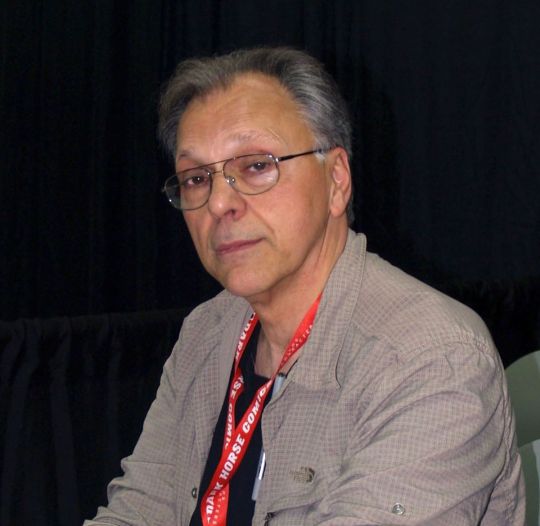
My concern had all and everything to do with the fact that this was a brand new company, located in [a suburb of] Chicago. I'd always worked for companies I'd visited and had day-to-day-dealings with. [But] they talked about a financial plan that would make it possible for me to get out from under the debt I had accrued working for [publisher] Byron Preiss [illustrating early graphic novels]. It was encouraging, so I went home and concocted a scenario, a pitch document, and that was it.
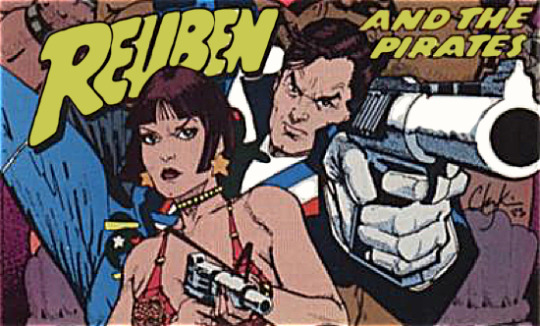
Chaykin devised a series set in 2031, a high-tech but spiritually empty, consumerist world in which the American government has relocated to Mars, leaving what remains of the U.S. to be governed by the all-encompassing corporation known as the Plex. The series star is Reuben Flagg, a former TV star drafted into the Plexus Rangers and posted as a deputy in Chicago, Illinois.
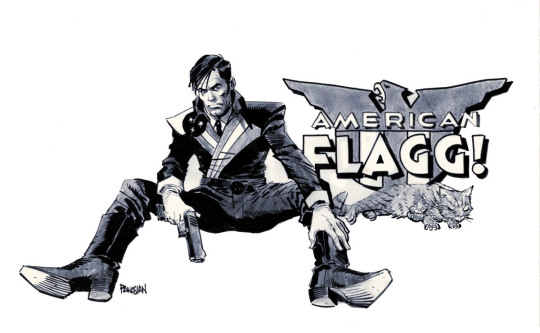
The first 12 issues, running through cover-date September 1984, consisted of four interlocking, three-issue story arcs. Chaykin recalled his difficulty in producing 28 pages of art and script monthly. "I was still a smoker and a drinker at the time. And [the output was such that] I'd never done anything like that before, and it was insane. It just devoured my life [and] I had no assistants. I didn't know how to work with an assistant at that point, and it was a very difficult process. ... I was trying to do a fairly high-quality product and I didn't want to slough it off."
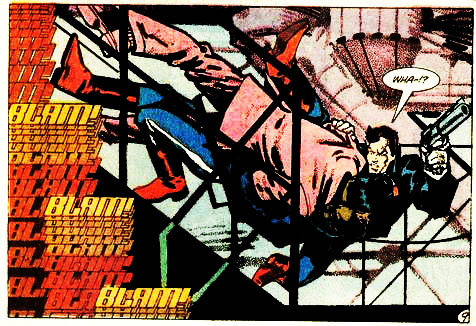
Chaykin made wide use of Craftint Duoshade illustration boards for American Flagg!, which in the period before computers, enabled him to add shaded textures to the finished art.Ken Bruzenak's lettering and logowork also won notice, as it was integral to American Flagg's futuristic, trademark-littered ambiance.
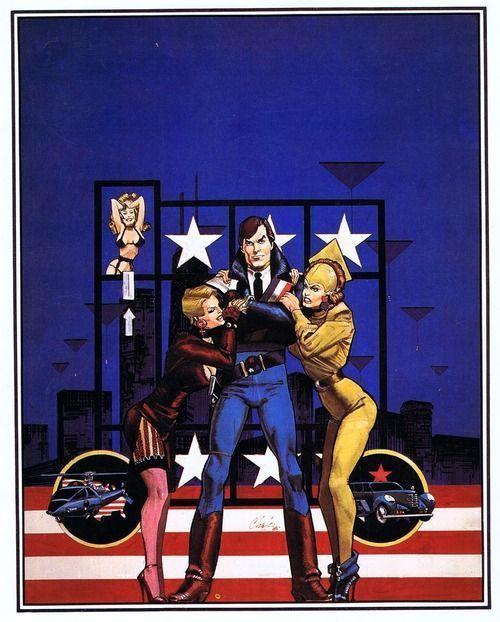
American Flagg's first dozen issues form one complete story that has influenced comic creators including Brian Michael Bendis and Warren Ellis. The comic made a huge splash at the 1984 Eagle Awards, the United Kingdom's pre-eminent comics awards. Chaykin and American Flagg! were nominated for ten awards, eventually winning seven. American Flagg! also won the 1983 Comics Buyer's Guide Fan Award for Favorite Comic Book and tied for the 1983 CBG Award for Favorite Character (Reuben Flagg).
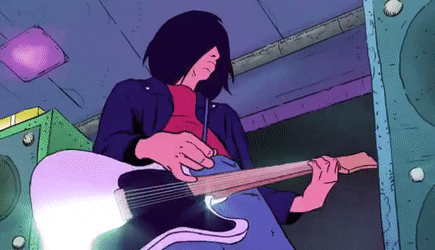
After issue #12, Chaykin continued the series while also working on such other projects as his revamp of The Shadow for DC Comics and the graphic novel Time2, based on characters introduced in a one-off American Flagg! special in 1986. During this time, Alan Moore wrote a back-up story that ran several issues and concluded in an issue-length story.
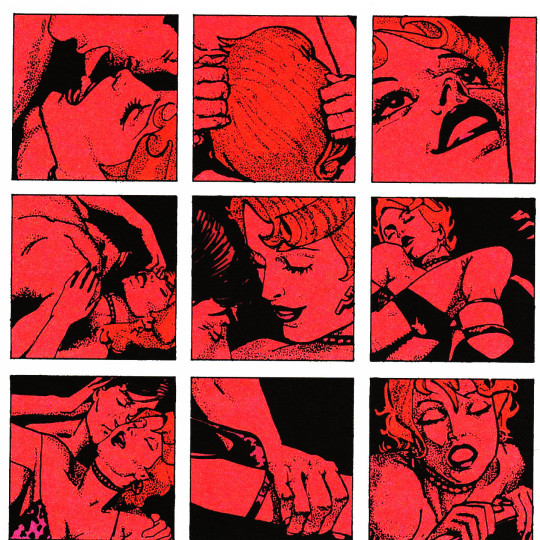
Eventually, Chaykin left, to be replaced on a regular basis by first Steven Grant then J.M. DeMatteis. Grant left after only seven issues due to creative friction with the series's new artist, Mark Badger. According to Grant, he had wanted to continue doing stories in the same style that Chaykin had established, while Badger wanted to take the series in new directions. Chaykin returned for a brief run to wrap up storylines before the first volume ended in March 1988. The title was relaunched a few months later as Howard Chaykin's Amerikan Flagg!. This run saw Chaykin return to write the first issue before handing over to John Francis Moore, with Mike Vosburg and Richard Ory penciling and inking the interior art, but the franchise failed to recapture its early success and was canceled after 12 issues.
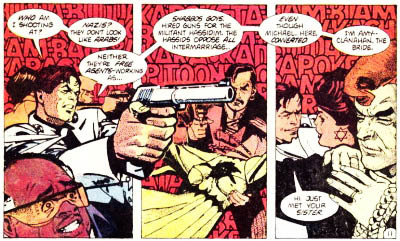
The story takes place in the year 2031, after a series of worldwide crises called the Year of the Domino (1996) has forced the U.S. government and the heads of major corporations to relocate to Hammarskjold Center, on Mars ("temporarily, of course"). In the wake of the American government leaving the planet and the Soviet Union collapsing from Islamic insurrections, there was a power shift throughout the world, with Brazilian Union of the Americas and the Pan-African League becoming the new superpowers on Earth.

However, the exiled American government, its corporate backers, and a group of technicians in the defected Soviet lunar colony of Gagaringrad form the Plex: a giant, interplanetary union of corporate and government concerns that conduct commerce and govern the United States from its capital on Mars. Many population centers are grouped around massive, fortified arcologies called Plexmalls and the law is enforced by the Plexus Rangers, the absentee Plex's Earthside militia.
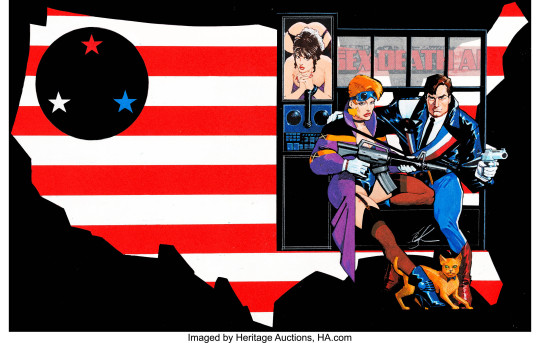
The Plex has formed the Tricentennial Recovery Committee, to get America "back on track for '76", but the TRC is in reality a plan to sell the United States off to the new superpowers and to leech off the remaining inhabitants before gaining true self-sufficiency. As a result, the Plex has outlawed non-combat related education, organized sports such as basketball and personal aircraft, restricted media to only one outlet, the Plex itself (although it has multiple channels), and advocates and glorifies the use of political violence amongst independent policlubs by providing money and firearms for its hit TV show Firefight All Night LIVE!, and covertly sterilizes the population by using a combination contraceptive and antibiotic called Mañanacillin to reduce the population.
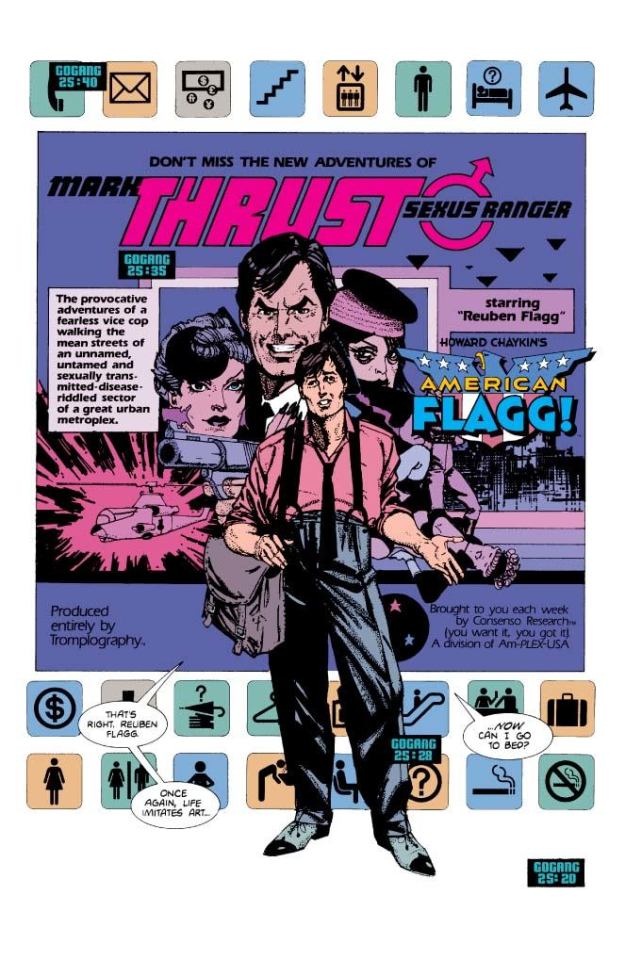
This all changes when former television star Reuben Flagg is drafted and transferred to Chicago's Plexmall to replace the local Ranger Hilton "Hammerhead" Krieger's fallen partner. He witnesses widespread graft and corruption throughout the Plexmall, but also a series of subliminal messages implanted in a television show that are causing outbreaks of gang violence. After he uses his emergency powers to interrupt the broadcast, he not only ends the violence, but also brings forth a series of events that causes the Plex to send in covert agents, the death of Hilton, and the unveiling of Q-USA, a secret TV station owned and operated by Krieger that opens Flagg's eyes to the nature of the Plex.
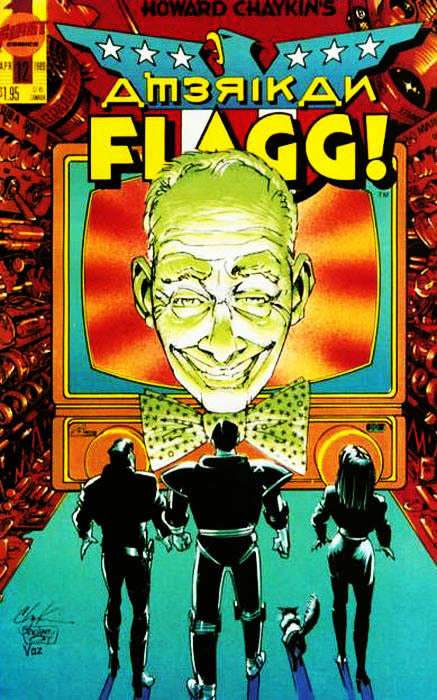
As the series progressed, Chaykin took less and less of a direct role in scripting and plotting the stories out, and by the third year of its run, he really had nothing to do with the book other than cover art. Stories began to violate the rules that Chaykin had explicitly stated in the writer's bible for the series (for instance, California was said to have slid into the Pacific Ocean, but in the final year of the book, California was merely shown to have been abandoned for reasons that were vague at best), and characterizations began to drift considerably as well. (Among other things, Flagg abandoned his interest in 1930s jazz, and was frequently shown listening to late-1960s rock, as well as becoming more of a traditional stern-jawed good-guy hero). After trying and failing several times to shore up declining interests, First Comics decided to lure Chaykin back into the writer's seat. "American Flagg!" wrapped up its principal storyline with issue #50. By this time, Reuben Flagg had traveled to Mars, overthrown the Plex, and become President of the United States. He then decided to separate Illinois from the United States and run it as his own personal fiefdom. All issues of this series took place in the year 2031.
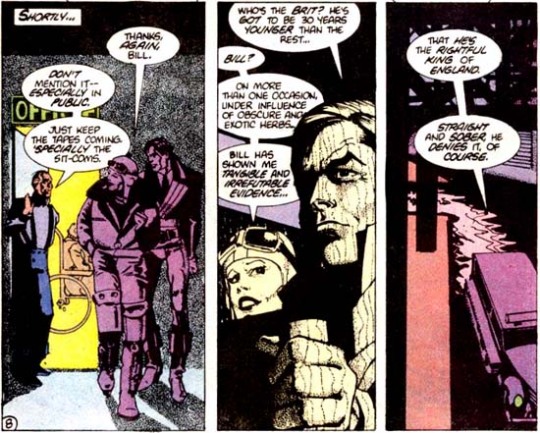
The next year, the comic was re-launched under the name Howard Chaykin's Amerikan Flagg! (The "K" and a reversed "r" were to reflect the fact that most of this series took place in Russia) and picked up from where the earlier book had left off (in 2032). There is some difference of opinion as to whether this new book was intended to be a limited run, or open-ended as is the norm with comics. In either case, it ended after twelve issues. The final issue ends with a photo album of the Flagg's future domestic life, with lots of kids, a screaming shrew of a wife, and a balding, overweight Flagg.
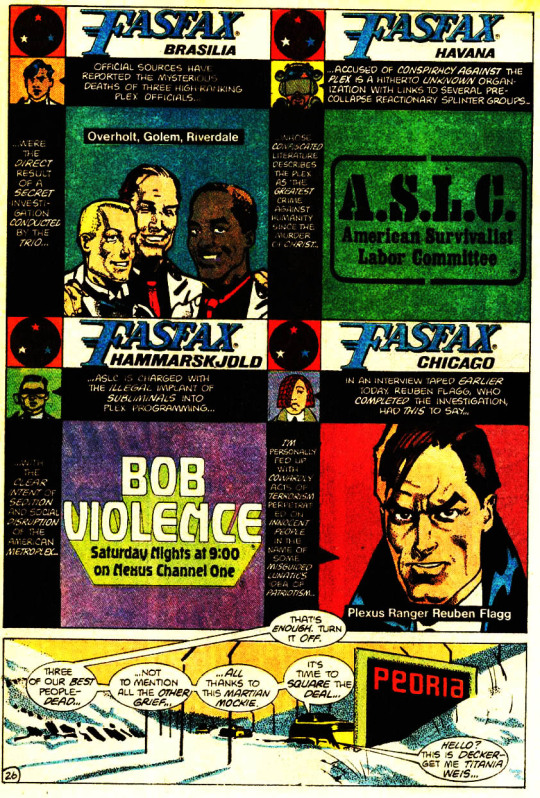
Characters
Reuben Flagg, born in 2000 at Hammarskjold Center, Mars, to Axel and Rebecca Flagg, was a stand-up comic and popular television star of the show Mark Thrust, Sexus Ranger. After he was made superfluous by CGI technology, he joined the Plexus Rangers and emigrated to Earth, being stationed in the Chicago Plexmall. Flagg is Jewish, and his parents' "undesirably bohemian" attitudes have given him an idealistic view of the United States that runs contrary to the Plex. He has a desire to set things right again, and through inheriting Q-USA, begins to set on that path.
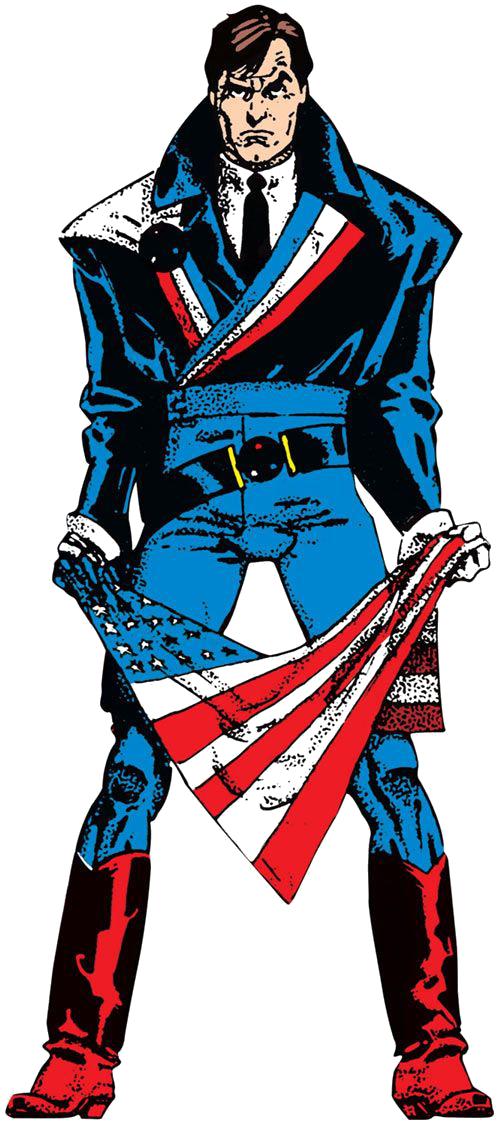
Raul the cat, an intelligent, talking orange tabby housecat. With the exception of his intelligence and his ability to speak (an ability whose origin is never explained), he appears to be otherwise a normal house pet. However, he has a customized set of cybernetic gloves, designed by Mandy Krieger, that give him opposable thumbs.
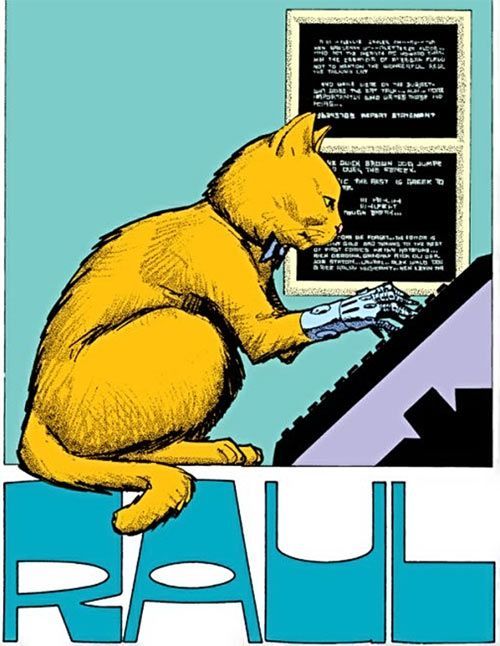
Hilton "Hammerhead" Krieger, was Flagg's superior at the Chicago Plexmall. A co-founder of the Genetic Warlords motorcycle gang along with Charles Blitz, but after his 13th arrest, the Plex drafts him because of his criminal experience. Intending to take advantage of the fledgling organization, he meets his future wife Peggy and stays with the Rangers. He does not trust anyone, not C.K., the mayor, not his wife Peg, not his daughter Mandy, and, while a Plexus Ranger, he especially does not trust the Plex. He runs an underground television station called Q-USA that broadcasts illegal sports, pornography, and pre-collapse movies and television shows. He is killed by a Plex secret agent, and his cat Raul gives Flagg the keys to the station. He also leaves behind a video explaining to his "heir" the truth of the Plex and the rules he wishes his successor to follow.
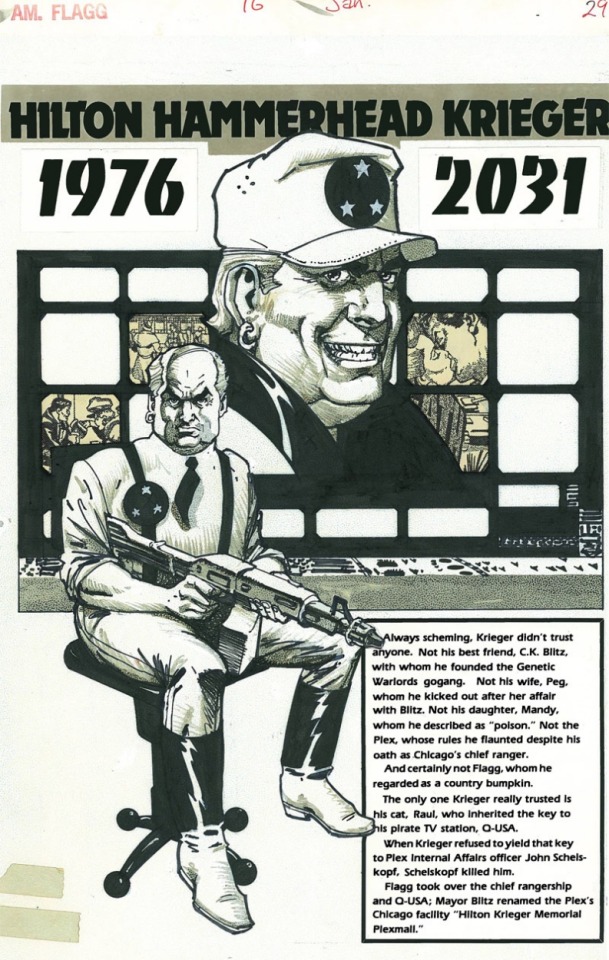
Amanda "Mandy" Krieger, daughter of Hilton, she is the air traffic controller for O'Hare Chicago Plexport. However, since the O'Hare Plexport only receives two flights a week, Mandy spends her time tinkering with electronics or getting into mischief. She later becomes a deputy to Flagg.
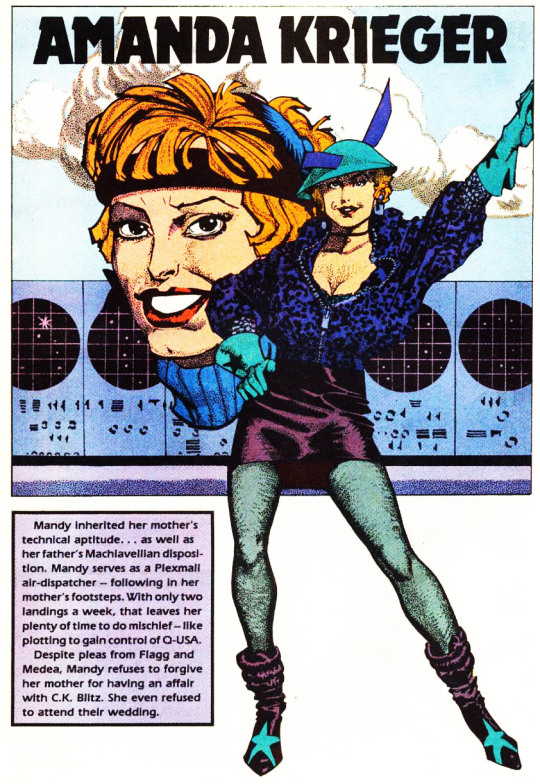
Jules "Deathwish" Folquet, captain of the Skokie Skullcrushers basketball team. Despite his punk appearance, his hulking size and the extreme nature of the sport he plays, Jules is quite intelligent. He is referred to as the "king of the two finger lobotomy." He first teams with Flagg to resolve a hostage crisis, but later forms the Video Rangers auxiliaries, and then becomes a Ranger deputy. He also later hosts a talk show with Raul called the "Him and It Show". In the second series, he renounces his violent ways, and, through a remarkable series of events, becomes Pope.
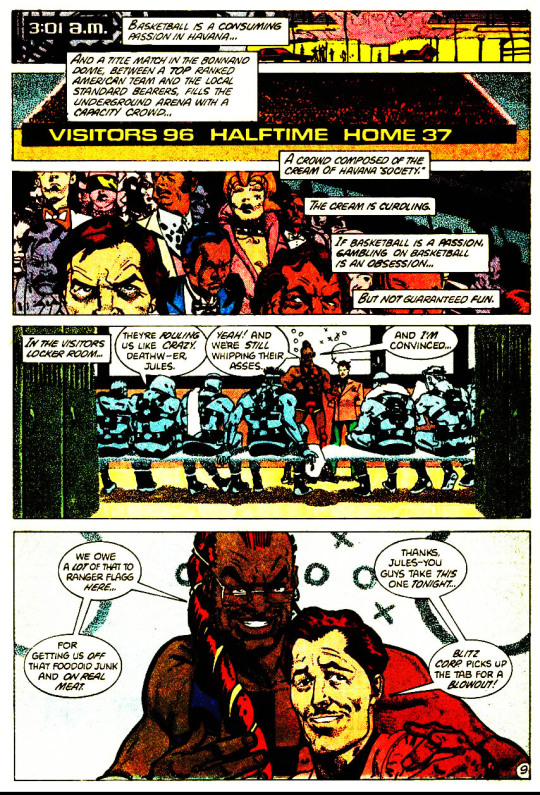
Charles Keenan Blitz, also known as The Honorable C.K. Blitz, a co-founder of the Genetic Warlords along with Hilton Krieger, also ended up getting drafted into the Plexus Rangers, but ended up leaving to become mayor of Chicago. Blitz has his hand in every deal, regardless of how illegal it may be; is extremely wealthy and corrupt; and has killed political opponents. As a side venture, he runs the Skokie Skullcrushers blackmarket basketball team. He is usually flanked by his two robot bodyguards, Bert and Ernie, named after "a private joke no one under 40 understands". He has had affairs with Mandy Krieger and with Peggy Krieger, while Hilton was fighting a brushfire war in Carracas, which lead to her being kicked out by Hilton and giving birth to...
Medea Blitz, the offspring of C.K. and Peggy. Early in the series, Medea is a wild child and hangs out with Cyril Farid-Khan, gang leader of current Genetic Warlords. She has a secret affair with Hilton Krieger, but after his murder, is considered a suspect and is involved in a traffic accident, which causes her to miscarry Krieger's child. In order to clean up her act, C.K. Blitz has her join the Plexus Rangers to straighten her out. As the series progresses, Medea is shown to become more and more accepting of the Rangers and becomes a decent team player in Flagg's group.
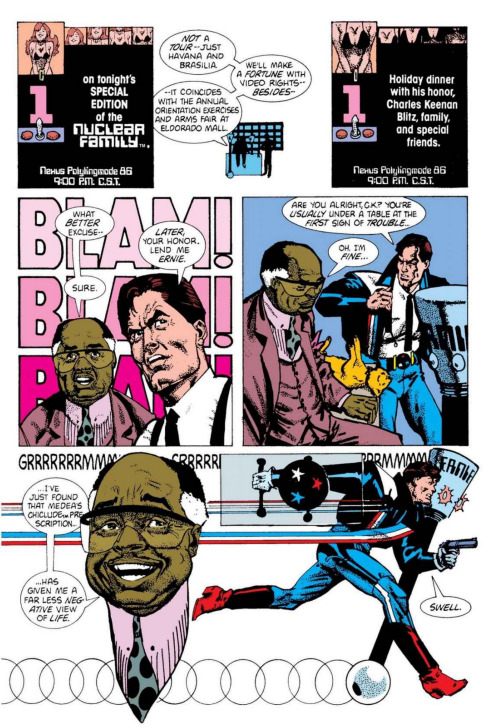
Sam Luis Obispo also known as Ned Beaumont, also known as Tom Slick. A hustler Reuben meets in Havana while escorting the Skokie Skullcrushers, he later partners with Flagg for most of his time in South America. He has an affair with the wealthy daughter of the Brazilian ambassador, which causes all sorts of problems for Flagg and himself.
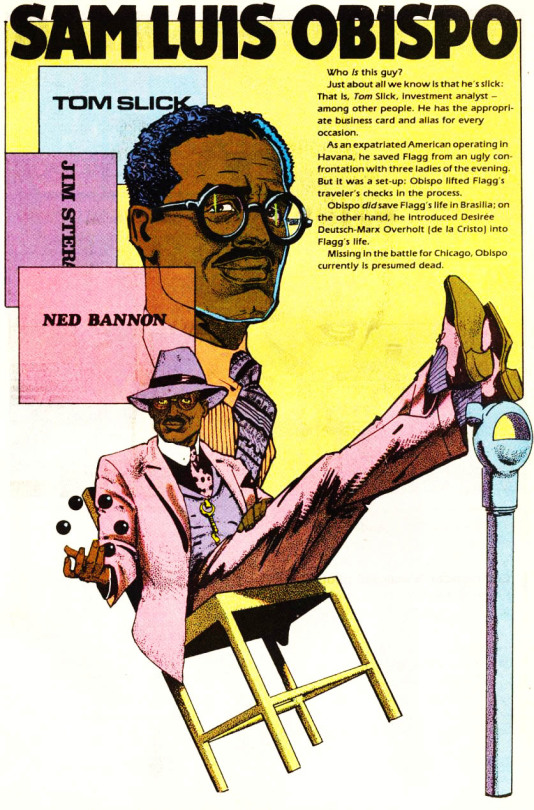
William Windsor-Jones, but his best friends just call him Bill. Bill is the youngest member of the Witnesses, a gang of octogenarian rebels. He helps Flagg out from time to time, giving him intelligence and technical support. He later has become a newscaster for Q-USA. Bill is Prince William, and the rightful heir to the now-abolished British throne.
Luther Ironheart, a robotic Plexus Ranger with a head that consisted of a holographic projection. Assigned to be Reuben Flagg's partner on patrol. While not very bright, he exhibited superhuman strength and agility.
#american flagg#american flagg!#mark thrust#howard chaykin#dystopia#dystopian#1983#silversteel rocks#first comics#howard chaykin's american flagg#bob violence#mojo el diablo#comic tropes#overlord comics#strange brain parts#reuben flagg
7 notes
·
View notes
Photo
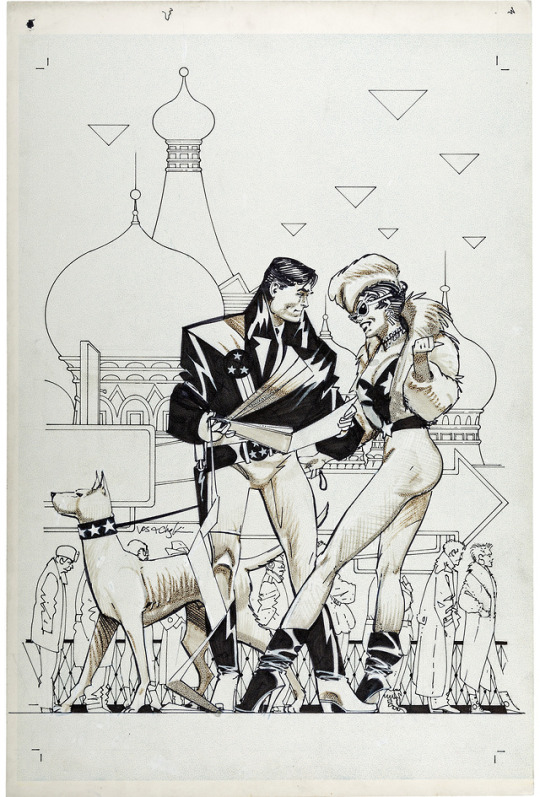
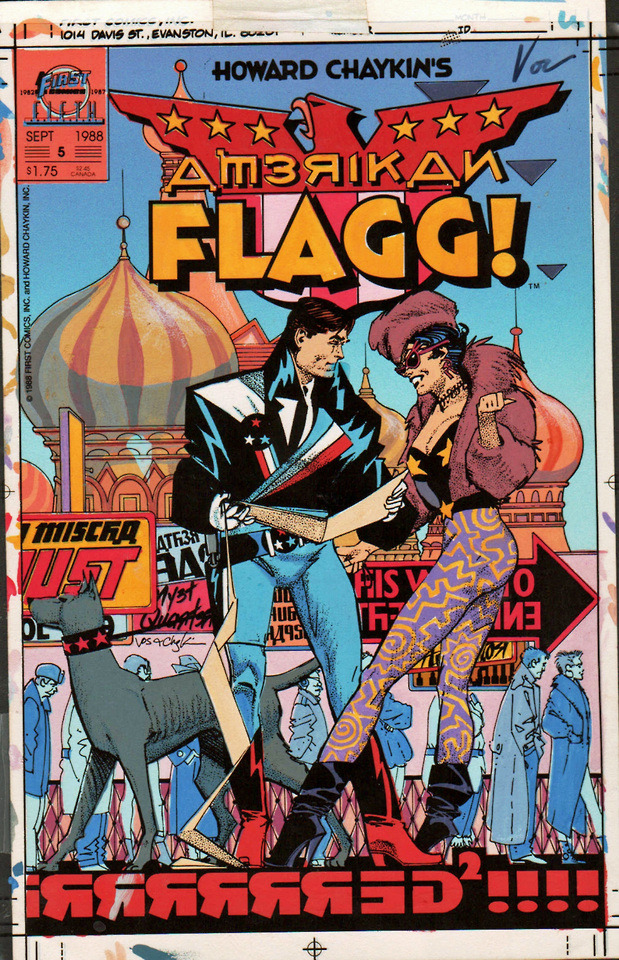
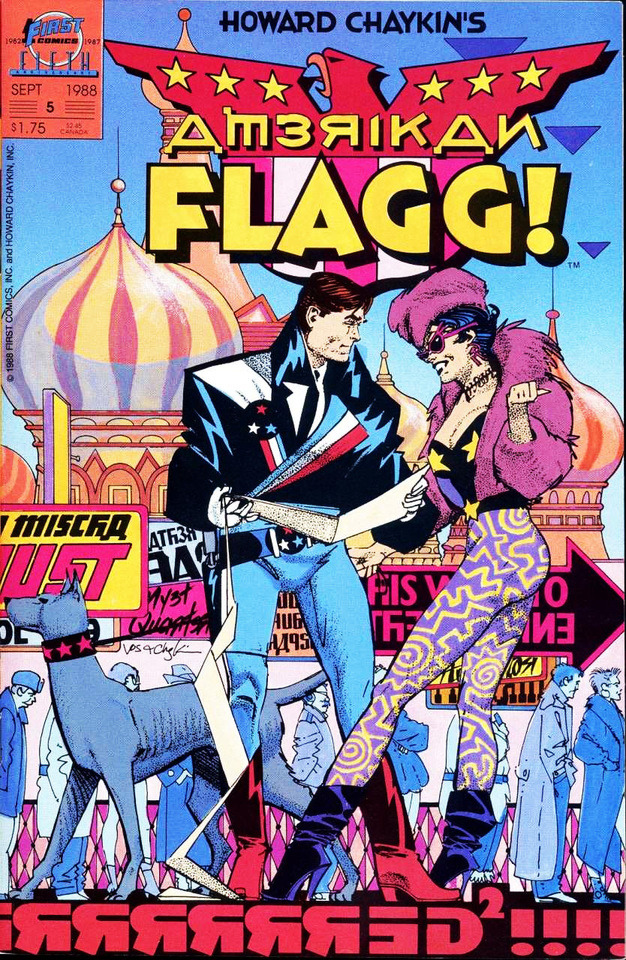
the cover to Howard Chaykin's American Flagg! (1988) #5 by Mike Vosburg and Howard Chaykin
32 notes
·
View notes
Photo
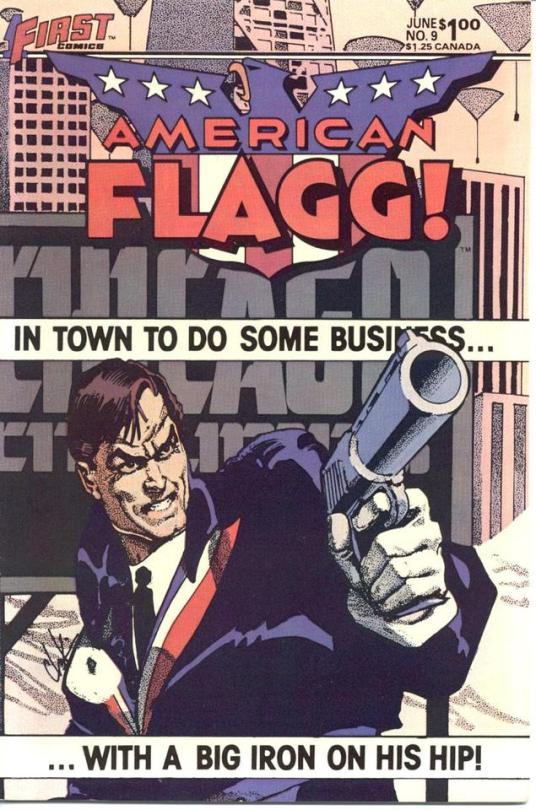
American Flagg! #9, June 1984, Pencils: Howard Chaykin
79 notes
·
View notes
Note
OK, I know this will probably be painful, and I may be a bad mutual for asking but...would you be willing to identify what, in your opinion are the bottom five worst Shadow adaptations, and give a detailed breakdown of why they were so lousy?
Oh christ, okay. I don't think you're gonna get as much of a detailed breakdown for these compared to some of the others, because I take more issue with adaptations that do have good qualities but also big or deep problems to talk about.
For example, I can't include Garth Ennis's Shadow in this list because the comic has a lot of strong points to it, despite a deeply, deeply detestable take on The Shadow's character, where as the rest of the Dynamite run doesn't reach neither the lows or highs of his run. Likewise, Andy Helfer's run has a couple or a couple dozen moments every issue that make me want to tear something to shreds in frustration, but it's also at many points a really good comic with great art and some occasionally very inspired writing. Really, I'd just be repeating myself talking about what I hate in those.
But, fine, let's list some of the others.

I think I'm just gonna have to get the elephant in the room out of the way here, and address that I won't be including Si Spurrier's 2017 Dynamite mini in this list, and I think at least some of you might be angry it's not Number 1 by default. I'm doing this because I intend to one day really revisit it, think about it and it's reception and what it was trying to do, and talk about it on it's own, now that it's been 5 years and everyone has moved on and we can maybe talk about it without kneejerk hatred driving everyone nuts (your mileage may vary on how warranted it was).
I'm also not going to be talking about James Patterson's new novel, because I haven't read it. It seems to be considered a forgettable potboiler by mainstream critics and a resounding failure by everyone who likes the character whether they've read the book or not, and frankly I don't have it in me to learn what the fuzz was about anytime soon, I got my hands way too full as is.
And I won't be including the Batman x Shadow crossovers here, because again, they do have a lot of virtues that put them far ahead of some of the really worst Shadow media, and I've talked enough about how badly I think they mangled The Shadow, which is really the big problem I have with them (well, that and Tim Sale blatantly copying a Michael Kaluta cover, that was really shitty). I don't really hate them anymore, I just get tired and frustrated thinking about parts of them, I said my piece as is. Really, my frustration over this comic is what inspired me to start writing about The Shadow here, so I guess in a way I do owe it at least that much.
5: Archie Comics's Shadow
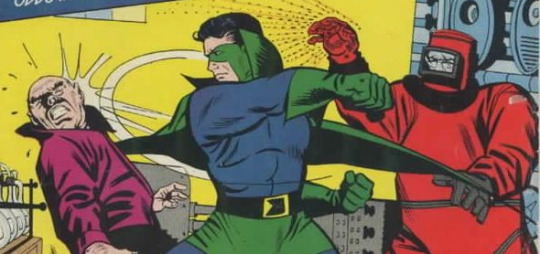
I think some of you might be wondering why this isn't ranked higher, but to be honest, I don't actually harbor any hatred towards this. I mean, I have to include it, but I find it kinda silly that some people even today actually care about the existence of this comic enough to hate it.
For fans back then? Oh yeah, obviously, but this dropped to such instantaneous backlash that it never really got to live past 6 issues. Really, everything wrong about it can be understood immediately from the covers, and I've actually read the comic in it's entirety to see if there was anything worth taking. I found only a couple of things of note but, no, this really is just a painfully mediocre superhero comic that happens to have a couple of Shadow names in it. If anything, it gets too much credit.
The actual contents of what it is are never going to justify it's reputation, but the existence of it and the disproportionate response to it is the funniest and most enduring legacy it could ever ask for. This whole comic is The Shadow's version of Spongebob's embarassing Christmas photo.
4: David Liss's The Shadow Now

This is another "The Shadow as an immortal in modern times" comic and I think you may have noticed the pattern with those by now. I may revisit this eventually and I do have some moments from it saved for reference, but overall: It sucks, and it doesn't even suck in a way that lets me talk much about it, it's a diet version of Chaykin's Shadow. If Archie's Shadow is a generic mediocre superhero comic wearing The Shadow's name, this is a generic crime story playing beats from movie. The Shadow is an asshole and not even a grandiose or sinister one, he just feels like a sleazy douche in a costume. The art is a 50/50 coin toss between appropriately moody and "Google images with a filter on them", I don't remember anything about the plot other than Khan had a bomb again and he had a daughter, and there were new versions of the agents and the Harry stand-in turned evil and Lamont shacked up with Margo's descendant which, uh, no. I don't really hate this but I really have nothing nice to say about this comic other than Colton Worley's art is nice sometimes. I can't really muster anything else to say here.
3: Invisible Avenger
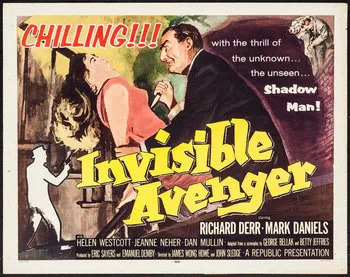
ZZZZZZZZZZZZZZZZZZZZZZZZZZZZZZZZZZZZZZZZZZZZZZZZZZZZZZZZZZZZZZZZZZZZZZZZZZZZZZZZZZZZZZZZZZZZZZZZZZZZZZZZZZZZZZZZZZZZZZZZZZZZZZZZZZZZZZZZZZZZZZZZZZZZZZZZZ
ZZZZZZZZZZZZ
ZZZZZZZZZZ...
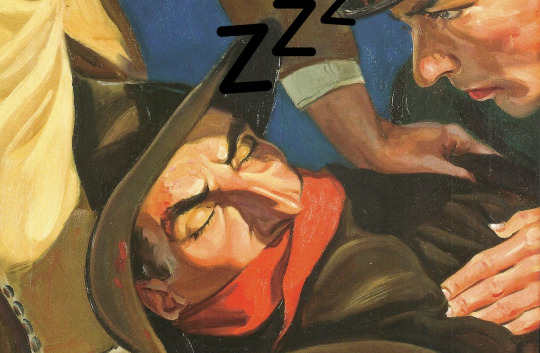
...uuh, wha-
Yeah, I remember nothing about this one other than it's painfully boring and nothing about it, nothing at all, works in the slightest and I drift off to sleep even now trying to give this a rewatch. To be honest pretty much every other Shadow serial not starred by Victor Jory sucks and I don't really have anything to say about them, this one is just the worst of the lot. I dearly wish there was a good Shadow tv series but, if it was going to be like this pilot? Good riddance.
2: Harlan Ellison's The New York Review of Bird

This isn't really a Shadow story as much as it's a Harlan Ellison story that happens to feature The Shadow, but man am I glad that Ellison's "Dragon Shadows" was canned, because holy shit what a goddamn nightmare Harlan Ellison writing The Shadow for real could have been, going purely by the one time he ever touched the character. New York Review of Bird is a purely farcical parody story that wears real, real thin even before "Uncle Kent" shows up, and we get to see in it what is by far the most detestable and irredeemable take on The Shadow ever put on print, and not even in a critique or deconstructive way or anything that could be remotely worth discussing.
I don't hold any particular affection for Harlan Ellison and his writing (despite liking some of it) and I've come to notice the major red flag that is finding someone who looks up to Harlan Ellison in any capacity as a person, and this story in particular really feels like Ellison aggressively trying to channel his jackass tendencies through every line, just him being nasty because he built a personal brand on being nasty. The only reason this isn't Number One is because it's a very short story that saw zero influence or reputation, and thus it only exists as a brief mention in The Shadow wiki, and a brief mention is all it really calls for.
1: Howard Chaykin's Blood & Judgment
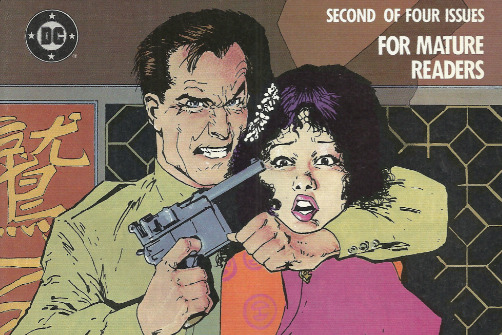
I'm guessing most of you already knew this one was in the top spot before I started writing.
I would actually rather not write a big piece on Blood & Judgment, because I think (or at least I hope) it's influence on The Shadow has waned a lot over the years and I would prefer to draw it the least amount of attention possible, but if I HAVE to talk about this, I guess I'd rather just vomit this out of my circuits now instead of giving it it's own post.
I would prefer to use a less unpleasant image on my blog, but if I'm going to talk about this comic, there's no image to better convey it than this drawing of macho asshole Cranston holding a sexualized mannequin at gunpoint. By leaps and bounds, Blood & Judgment is the most misogynistic Shadow story I've ever read. It's ironic that Chaykin justified the rampant misogyny he gave The Shadow with the idea that this is just a man from the 30s would act like, when he admits in the same breath that he never even touched the stories, and he wrote a story more sexist and demeaning to it's female characters than anything, literally anything, written in the Shadow pulps. It's almost impressive even.
I'll paste some segments from Randy Raynaldo's review
In Flagg, he intended to present his own point of view on American society while keeping his work tongue in cheek and acessible. But this vision dimmed, and Flagg had become a vehicle by which Chaykin could play out fetishes and portray gratuitous and stylish violence.
In The Shadow, stripped of the political and social veneer which was supposed to make Flagg unique, Chaykin's sensibilities and excesses become disturbingly apparent. For all of his liberal posturing, Chaykin's work demonstrates zero difference from the same kind of mentality exploited and made popular by similarly violent popular culture icons like Dirty Harry and Death Wish.
More than half a dozen individuals are indiscriminately and violently murdered in the first issue. Although the victims are characters who played major roles in the myth of The Shadow, we feel little sympathy for them, even for those of us who knew these characters at the outset. Who dies is unimportant, it's how they die that is the fascination.
Chaykin uses sexual decadence as a means by which to establish villains, and undercuts this device by making the protagonists as promiscuous as the villains. For all of Chaykin's seemingly liberal leanings, he demonstrates very little sensitivity in his portrayal of women.
Because everything works on rules of three, this comic also follows the pattern with other works mentioned here, as this isn't Howard Chaykin writing The Shadow: it's The Shadow reimagined as a Howard Chaykin character. He looks and acts exactly like Reuben Flagg and the typical macho protagonist of Chaykin's other works, he's a cynical sleaze with an entirely new origin who half-assedly dons a garb to machine gun people, and I already wrote a separate piece on why the machineguns are kind of emblematic of everything wrong with this take.
I understand that Chaykin has, or used to have, a big following of sorts, and I've tried to wrap my head around this for years, but I genuinely still don't get why Shadow fans stomach this comic unless they happen to be Chaykin fans first and foremost, I really don't. Everything, fucking everything Shadow fans hate about modern depictions of the character can be traced right back to this. The parts that stuck and changed the character for the worse, like him being defined as an immortal, bloodthirsty warmonger who got all his skills and powers from a magic city in Tibet, or Lamont Cranston being a coward who fears and hates the Shadow, or his agents being expendable slaves, stuff that has been ingrained into the mythos through this and the Alec Baldwin movie and other comics, to the point that people now think of it as the norm, that it's the baseline of what The Shadow is, and I hate it, I genuinely fucking hate it,
I hate it so much that it's a big part of the reason why I created this blog and why I want so badly to get to write The Shadow, because I plainly couldn't stand not having ways to tell people that this is all wrong, that this is actively shooting down the character's odds for success, and that they are missing out on something really great, because the well has been tainted with garbage that won't go away and everytime I read the words Shambala in a Shadow comic, even an otherwise good or great one, I get just a wee bit cross.
The only semi-redeeming aspects I can think of for this comic is one or two cool moments, like when The Shadow hijacks a concert using his Devil's Whisper or when he tames dogs with a stare. Just breadcrumbs of "not garbage" amidst an ocean of anything but. I hate that talking about why I hate this comic in-length can almost feel like I'm still enticing people to check it out of curiosity, but if you wanna do that, fine, just know this: The worst part of Blood & Judgment, even if you don't care at all about what it did to The Shadow, is that it's boring.
It is a deeply boring comic. If you like Howard Chaykin to begin with, you'll probably like this okay (although even Chaykin fans told me that this is his weakest work and that even he seems to agree). If you don't, I plain don't see what you could get out of this.
The comic itself is just nothing. It's the comic book equivalent of a pre-schooler trying to get a reaction by swearing. It has nothing whatsoever other than half-assed attempts at shock value. The plot isn't there, the ideas are stale, the dialogue is needlessly oblique and comprised entirely of unfinished sentences, interrupted conversations and one-liners without build-up. The characters are all unlikable and uninteresting stooges with no personality, or joyless cartoons. There's no heart or emotion or logic, and it isn't even funny enough to succeed as just an outrageous exercise in 80s excess. There's nothing in here.
I get "why" it was popular enough at the time, a rising star creator penning a modern revival of an old character based on controversy that pissed off the old fans, it's an old story that still gets repeated today. But manufactured controversy is not a replacement for storytelling and it rarely ever exists to benefit the people who actually want to enjoy the stories, it only benefits those for the crude benefit of those who want to sell you something out of the controversy.
I guess they got their money's worth back then.
------------------------------------------------
Phew, okay, I did it, I finally vomited out a piece on Blood & Judgment and some others, allright, let's put this piece of negativity behind us now.
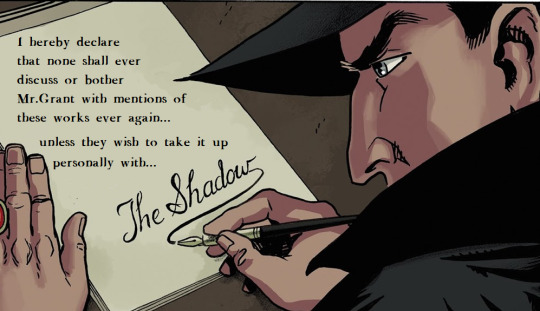
29 notes
·
View notes
Photo

Midnight Enchantress uses her powers to make sure to get rid of Ai for good, but Asumi (Delilah) has detected it quickly and she pushes Ai out of the way and takes the hit that immediately damages and shuts her down, shocking Ai, Raven (Junko/Juno), Crescent, Lightning, Michuri, and Jabba, but Ai is the one who is defiantly horrified of what happened. Midnight Enchantress didn't except that to happen, but she couldn't care less of it and she sends her minions to take Asumi as her damaged prisoner. When Playmaker and Midnight Enchantress duel to save everybody (Starr, Harklight, Lady Diamond, Flagg, Mamiko, Rascal Rosie, Cowgirl Lily, Emerald, Songstress Melody, Siren, Queen of Hearts, the real Risa Kogami, Touma, Akari, Beauty, and Revolver), War Hunter (Takayuki/Ethan) manages to free himself, Twilight Dancer (Miyako/Annie), Professor Neutron (Hideaki/Reuben), Liberty Girl (Asuna/Thea), Soulburner (Takeru/Theodore), Blue Maiden (Aoi/Skye), Artemis (Rikona), and Terra (Tsunade/Piper) from their cells that Midnight Enchantress puts them in. Professor Neutron and Artemis began to repair Asumi. Once Midnight Enchantress is defeated by Playmaker and the real Risa is set free and everybody is brought back from the virus stone, Professor Neutron and Artemis manage to fix Asumi back up, but she isn't powering up. Ai, who is in tears, begs Asumi to come back to him and that he can't lose her. He has already lost his Ignis friends, he can't lose the love of his life too. Soon, Asumi started to beep a little, and she began to open her eyes and looks at Ai. She got curious on why Ai is crying. Ai then grabs Asumi and hugs her tight, like she is his life line. Then Ai tells Asumi to never leave him ever again, which Asumi promises she won't and hugs Ai back.
Note: There is no season 4 for the canon version of VRAINS. This is only for my version of VRAINS. Also, characters like Asumi, Midnight Enchantress, Raven, Crescent, Michuri, Jabba, and the rest do not appear in the canon version of VRAINS, that is also in my version of VRAINS.
#vrains#yugioh vrains#ygo vrains#ai (vrains)#human ai#asumi nishumura#delilah moore#androidaishipping#this is just for my version of VRAINS
2 notes
·
View notes
Photo
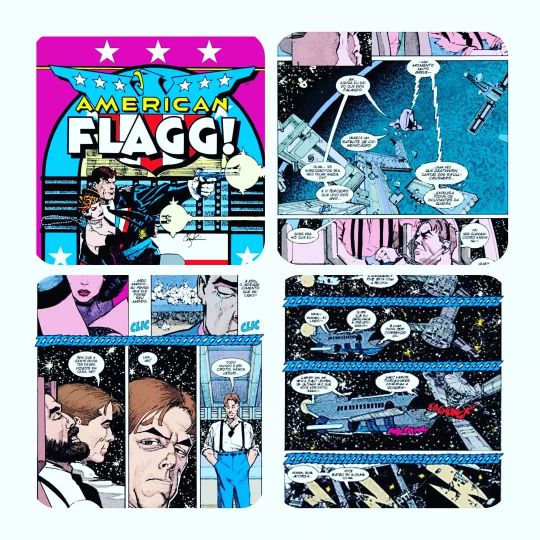
Garanta já o seu exemplar !😍😍 🤑🤑Aproveite promoção 🤑 Se interessou e não conhece Não perca tempo de adquira AGORA! Acesse o link pela BIO ou 👉👜 ao lado da imagem! Publicada originalmente no início da década de 1980, ''American Flagg!'' conta a história do ranger Reuben Flagg enquanto navega por uma paisagem americana que, em retrospecto, parece mais profética a cada ano que passa. #flagg #mythoseditora #mythos (em ClubeComiccon) https://www.instagram.com/p/CWwRmX2LtN9/?utm_medium=tumblr
0 notes
Text
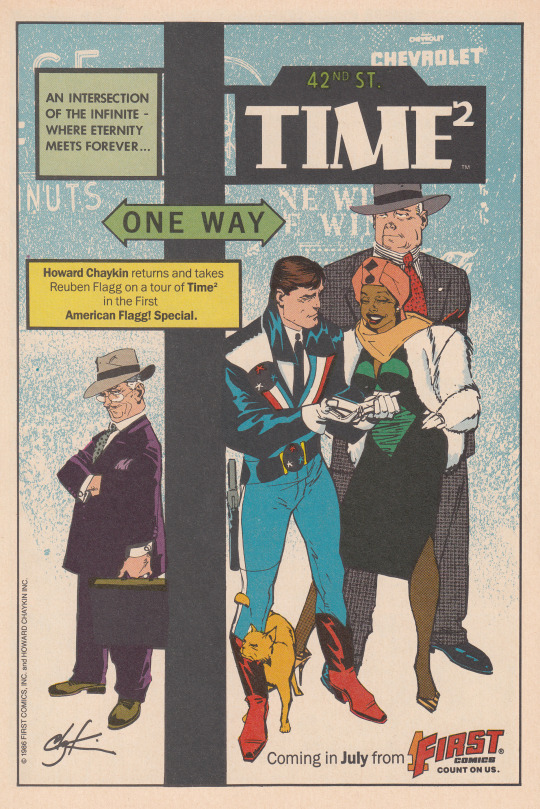
American Flagg! Special house ad (circa September 1986)
5 notes
·
View notes
Photo
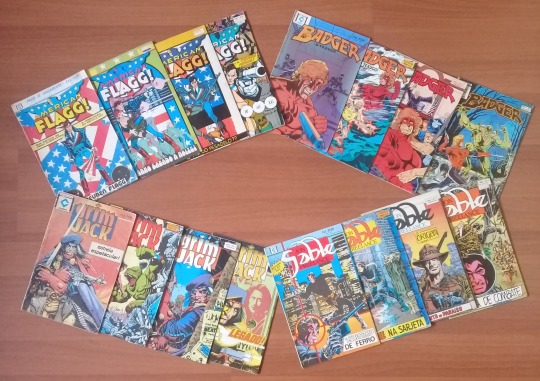
Flagg / Badger / Grimjack / Sable.
#cedibra#first comics#80s#american flagg#badger#grimjack#grim jack#jon sable#reuben flagg#howard chaykin#mike grell#john ostrander#mike baron#timothy truman#first#comics
2 notes
·
View notes
Photo
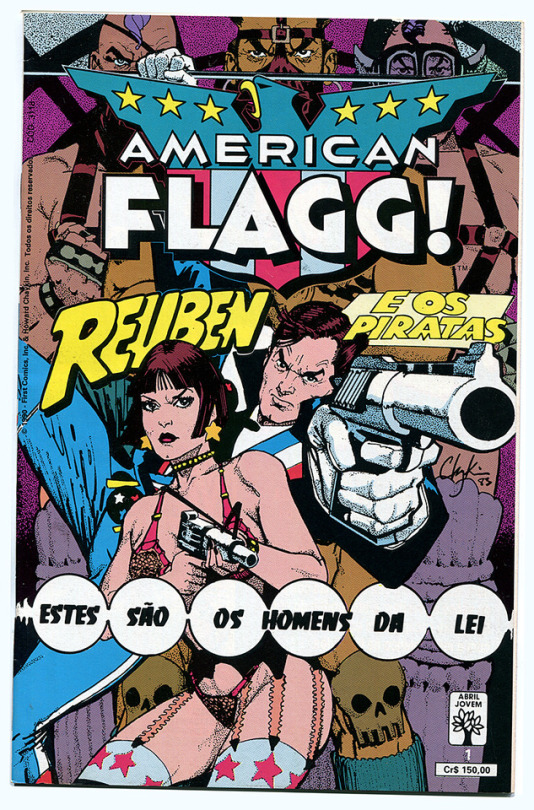
https://goo.gl/yTPJS7 American Flagg! #1 Howard Chaykin Editora Abril, 1990
Este é o número 1 de uma série de seis revistas que a Abril Jovem publicou em 1990 com o icônico personagem criado pelo genial Howard Chaykin. Edição em estado de banca! São 36 páginas coloridas em papel couchê com as aventuras futuristas de Reuben Flagg. A história foi publicada originalmente pela First Comics, nos Estados Unidos, em 1984.
12 notes
·
View notes
Text
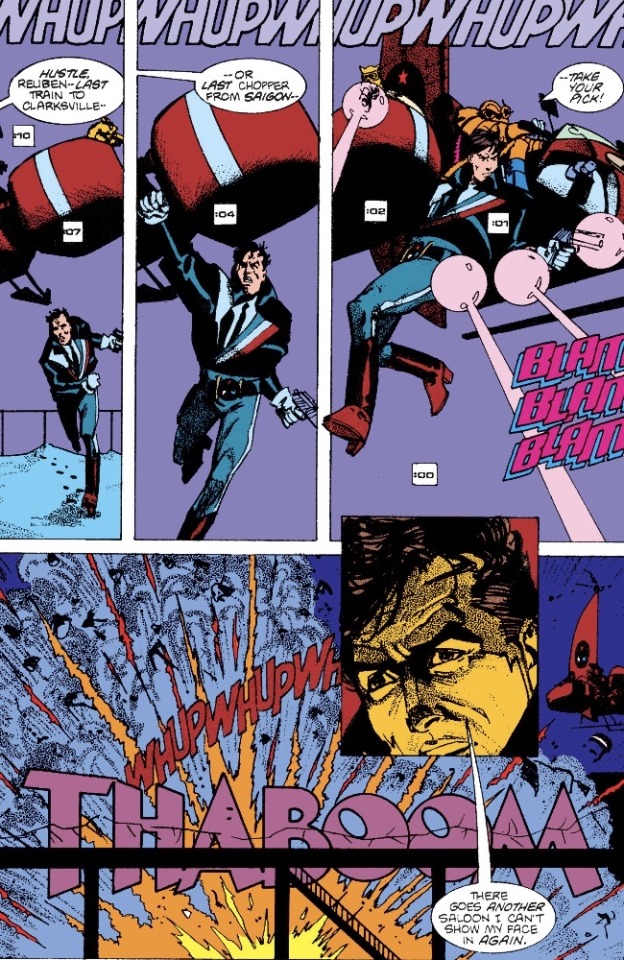
American Flagg! (1983) #10
10 notes
·
View notes
Photo
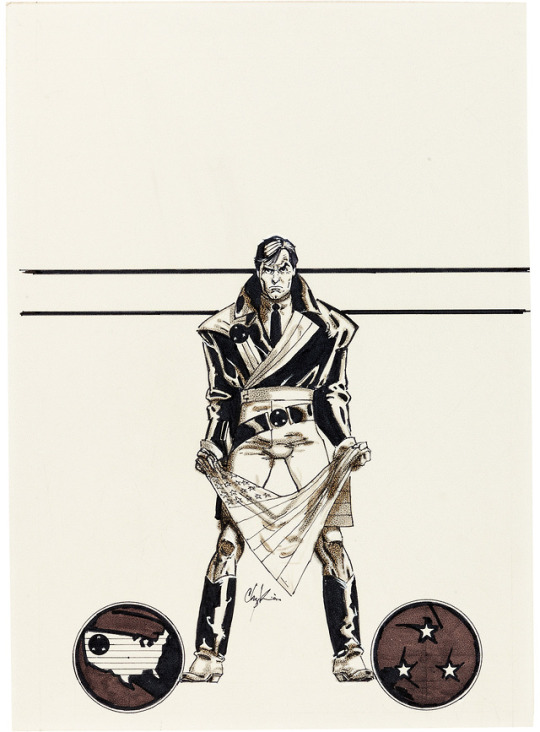
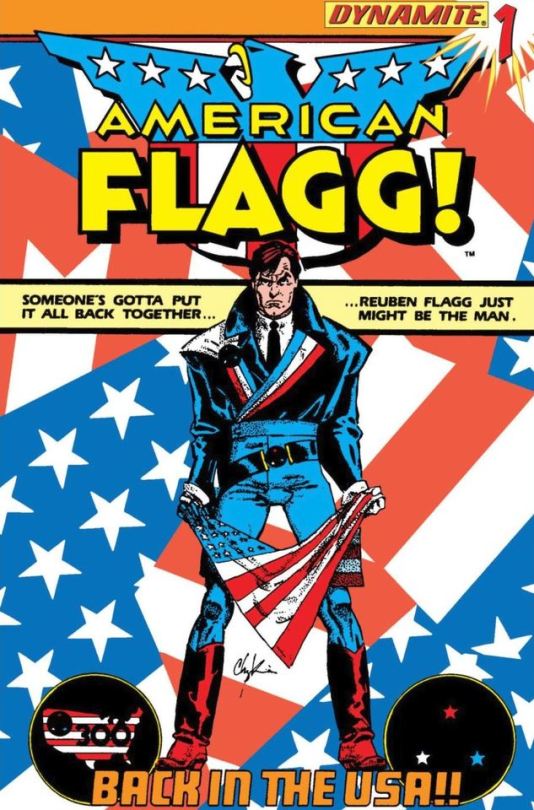
the cover to American Flagg! (1983) #1 by Howard Chaykin
24 notes
·
View notes